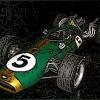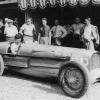I have never been a fan of handicap car races but have been wondering if anyone ever saw a handicap race where all the cars finished in one large bunch?

Handicap Race Finishes
#1

Posted 15 April 2017 - 14:36
Advertisement
#2

Posted 15 April 2017 - 15:49
The only one I ever witnessed was Road America in 1975. It was a blast to watch, though, and won by Vern Schuppan in a Gulf Mirage-DFV. It was mostly an excuse to have a headlining August race to fill the vacant Can-Am date, which was fine as several showed up.
The best handicap format would be one that was only announced as such right before the race!
Edited by E1pix, 15 April 2017 - 15:52.
#3

Posted 15 April 2017 - 16:25
As a former handicapper I can say, first of all, that, under RAC-MSA Rules, there is a useable sanction against sandbagging
Q 12.10.2. In the case of races in which the handicap is wholly or partly based on practice times, a driver who in any lap improves upon his best practice lap time by more than 5% may be excluded by the Clerk of the Course. This penalty may be waived if the Handicapper advises the Clerk of the Course of any extenuating circumstances.
Before the event we try to assess the likely lap times for all of our customers and only regard practice as a guide, so we hope never to use Q 12.10.2 unless someone is trying it on. Once when we had asked someone why his practice time was slower than we thought it should be, we were not quite convinced by his explanation so kept our eye on him. His standing lap was faster than his best flying lap in practice, so we had agreed with the CotC to exclude him before the five-lap race had even finished!
Back to the question put by Rob, yes we did get a good bunch at the finish often enough to convince us we were doing things right. However what we regard as a good bunch is tempered by our knowledge of our methods. Since we keep records and work in whole seconds per lap, getting 'em all across the line in 10 seconds is a good bunch at the end of a five-lapper. However I did one race at Castle Combe where one car spun off and restarted never to catch up and another ran away with the 10 lap race but from first to last 25 seconds covered the field!
Finishes at Silverstone Club circuit could be exciting if we got things right and they all had to take Woodcote together. At an Eight Clubs they were all piling into the corner for the last time when one David Bettinson, in a special of Lotus 7 character, nipped past the lot on the inside in a win-or-bust dash for the flag. Mercifully he won as if he had even run wide, never mind spinning, he'd have taken everyone off.
Edited by Allan Lupton, 15 April 2017 - 16:25.
#4

Posted 16 April 2017 - 11:30
Thanks for the insights Allan.
One question, did you give the faster cars an allowance for the number of cars they would have to overtake?
#5

Posted 16 April 2017 - 12:56
In addition to the Road America 252 Handicap mentioned by E1Pix above, the track tried it again the next year, only this time for F-5000 cars. This was the third race for F-5000 at the track that year, so the handicappers, headed by SCCA Tech Chief John Timanus, had ample lap times to use in setting the times. As it was, they had five groups leaving at staggered times for the 100 mile event. The last group consisted of two cars, the Lola T-332s of Brian Redman and Al Unser. However, Unser was against the handicap format from the start, and refused to participate. So, Redman left by himself, a full three and one-half minutes after the first group. As I recall, there were just over 30 cars in the race.
To get to the end of this narrative, Warwick Brown in a VDS Lola T-430 took the lead in the latter part of the race and held it into the final lap. However Vern Schuppan, in the AAR Lola T-332, caught and passed him to take the win. Brown was second with Derek Bell third in a Theodore Racing Lola T-332. Redman finished sixth, 3:30 too much to make up in 100 miles.
Tom
#6

Posted 16 April 2017 - 14:16
Thanks for the insights Allan.
One question, did you give the faster cars an allowance for the number of cars they would have to overtake?
Yes we had a rough and ready system of overtaking allowances which we had to formalise when we put our system on a computer. Whatever you use won't be right of course - if all the overtaking was on the main straights no allowance was really needed and if the overtaking was at or near corners more was needed than we gave. What's more, on several occasions drivers of slower cars told me they needed a "give way" allowance for when they kept out of the way of something much faster.
#7

Posted 17 April 2017 - 18:42
I remember a not very bright friend of mine who was incensed that the handicappers had handicapped him at too slow a lap time - he felt insulted. As it turned out, they got it about right over a race distance as he finished in the middle of the pack.
#8

Posted 17 April 2017 - 18:51
I remember a not very bright friend of mine who was incensed that the handicappers had handicapped him at too slow a lap time - he felt insulted. As it turned out, they got it about right over a race distance as he finished in the middle of the pack.
Ah, I wonder if he was one of our customers!
From a handicapper's point of view, as we had around 30 competitors in each race we said that in our ideal world everyone would finish 15th
#9

Posted 17 April 2017 - 19:02
At state level events in the past there was often handicap events. Problem was timekeepers do an ok job,,, but you have to pass the cars, a car a second a lap slower is very hard ro pass, s\ome one 10 sec slower is easy. I have never won a handicap, worse never from the back, usually gave up as it was obviously impossible. I feel I got second once.
#10

Posted 17 April 2017 - 21:51
Dad used to compete in handicap races at Oulton Park & Aintree in the 50s, in whatever Austin saloon he had at the time.
On one occasion at Aintree, he just pipped Jean Bloxham [later Jean Salmon] in her Aston but she was going so fast she passed him just after the line...in the paddock, she apologised for passing him, apparently etiquette in those days was to stay in finishing position until they got back to the paddock......
#11

Posted 18 April 2017 - 04:31
Here in Australia they have a handicap speed comparison that is a bit of fun on Grand Prix weekend. Sometimes it's pretty close. Can't see it really working in a proper race though.
https://www.youtube....h?v=3RuUp5MT3Uc
#12

Posted 18 April 2017 - 07:07
Down in Tasmania in the 60's and early 70's, handicap races were always the last races of the meeting and were very popular, especially at Baskerville. Often they were the best races of the day.
Martin Chambers was the handicapper at Bask back then and he was very clever. The grids were invariably quite small - usually 10-12 cars tops - and he knew what each driver/car combination was capable of.
The shot of the Div2 Sports&Racing field has Dick Crawford in his little Trowjm Yamaha off first with Bert Howard in the Lola Mk1/1100 Climax at the back. It was a running battle between Crawford and Chambers
for years to see if Dick could outfox him and at one meeting where it was Dick's 60 something birthday, Martin let him win by a country mile! Back then Dick was probably one of the oldest CAMS licence holders in the country
so it was accepted as a good thing.... The shot of Tony Calvert in the ex Bessant Lotus Cortina and Tony Watts in the Cooper S (still in the family to this day too) was virtually a dead heat, only a bumper bar in it.
Back in the day there were lots of places for the quicker cars to overtake, especially up the hill and down Shell Straight into Firestone Cnr - they were carving them up left right and centre.
One of the best handicap races I ever saw had only two cars in it - John Goss off first in the Tornado Ford (one of his last Tassy races before moving to NSW), and Lyn Archer in the Elfin Catalina 1.5 pushrod Ford.
They were both driving their hearts out and Lyn missed out by half a car length at the finish! The bottom shot is 1972 - Thomson Camaro, Pare Mustang , Wigston Escort T/C and Calvert Mustang - Copyright oldracephotos/Harrisson



Edited by ellrosso, 18 April 2017 - 07:12.
#13

Posted 18 April 2017 - 07:09
In speedway racing it was common for handicaps to be done on "distance", eg the slower drivers would start on "scratch" (usually the start/finish line) and then the remaining drivers would be spread around the track. The largest handicap I came across during my Windsor RSL Speedway research was 380 yards in a 20 lap race. Some tracks had handicap distances marked on the fence to aid the cars lining up. All cars would then start at the same time. Does circuit racing prefer to use a "time" handicap, with cars leaving the start/finish line at staggered intervals. Have there been any examples in circuit racing of the "distance" formula being used instead of the "time" formula?
#14

Posted 18 April 2017 - 07:36
Cars were staggered all around the circuit, there was someone there to flag them away and a rocket was set off at the start/finish line to give the starting signal.
#15

Posted 18 April 2017 - 07:43
I've not come across distance benefits/handicaps except whole laps. As Ray's post makes clear, on a circuit of normal lap distance you need a local starter at each distance and a signal system to synchronise starting - a speedway track, being short and everywhere being visible from everywhere else, wouldn't have that difficulty.
At our level of racing we used credit laps when the appropriate time benefit would bring the competitor round to the Start before the fast cars had left. Pre-war at Brooklands the track was so wide that it wasn't unsafe to let cars pass the start line so very long time benefits could be and were used.
In races such as the 1928 and '29 Ulster TTs credit lap handicaps were applied on a class by class basis rather than as an attempt to equalise chances by a handicapper on the day.
Edited by Allan Lupton, 18 April 2017 - 07:47.
#16

Posted 18 April 2017 - 10:29
I've not come across distance benefits/handicaps except whole laps. As Ray's post makes clear, on a circuit of normal lap distance you need a local starter at each distance and a signal system to synchronise starting - a speedway track, being short and everywhere being visible from everywhere else, wouldn't have that difficulty.
At our level of racing we used credit laps when the appropriate time benefit would bring the competitor round to the Start before the fast cars had left. Pre-war at Brooklands the track was so wide that it wasn't unsafe to let cars pass the start line so very long time benefits could be and were used.
In races such as the 1928 and '29 Ulster TTs credit lap handicaps were applied on a class by class basis rather than as an attempt to equalise chances by a handicapper on the day.
Allan
Getting it right, do you recall a Silverstone handicap race, VSCC or Seven Fifty or whatever, when a whole bunch, and I mean a whole bunch 10/12, hurled themselves down the club straight and somebody at the front spun and crossed the line backwards, and nobody hit anybody?
#17

Posted 18 April 2017 - 15:52
Allan
Getting it right, do you recall a Silverstone handicap race, VSCC or Seven Fifty or whatever, when a whole bunch, and I mean a whole bunch 10/12, hurled themselves down the club straight and somebody at the front spun and crossed the line backwards, and nobody hit anybody?
I don't remember that incident but I did hear of it. Could easily have been at an Eight Clubs (as was my David Bettinson tale in post 3) or VSCC.
Puts me in mind of Bentley driver Harry Bowler who said something on the lines of "I don't mind being out-accelerated after Becketts but I do object when some cut-and-shut special nips past and spins in front of me after I've made all my braking arrangements"
















